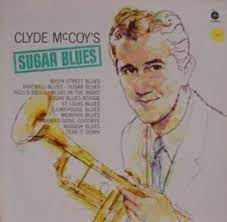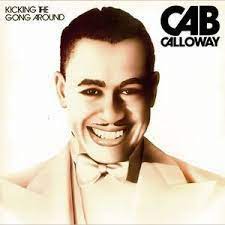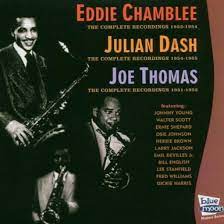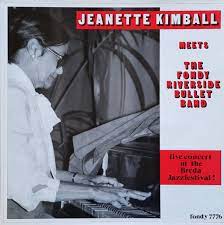
Daily Dose Of Jazz…
Clyde Lee McCoy was born December 29, 1903 in Ashland, Kentucky to the family that feuded with the Hatfields. He began mastering the trumpet without formal instruction, after the family moved to Portsmouth, Ohio in 1912. This led him to perform regularly at church and school affairs. Five years later he was performing on the Cincinnati riverboats, and on the Mississippi River side-wheelers the Island Queen and the Bernard McSwain. He became one of the youngest musicians on the river at age 14.
In 1920, accepting an invitation for a small band to play at a Knoxville, Tennessee resort, his Chicago Orchestra rehearsed on the train and won the approval of George Whittle and the patrons of the Whittle Springs Hotel and Spa. After a two month engagement the band officially became known as the Clyde McCoy Orchestra.
In the late 1920s McCoy developed the signature “wah-wah” sound by fluttering a Harmon mute in the bell of his trumpet. In 1967, a similar effect was made for electric guitar with the introduction of the Vox Clyde McCoy Wah-Wah Pedal. Having nothing to do with the use or development of the pedal,Clyde’s name was only used for promotion.
Over the course of a seven decade career Clyde was based at various times in New York City, Los Angeles, California and Chicago, Illinois. He is best remembered for his theme song Sugar Blues, written by Clarence Williams and Lucy Fletcher, and also as a co-founder of Down Beat magazine in 1935. The song was performed with vocals by Bob Wills and his Texas Playboys, Fats Waller and Ella Fitzgerald.
Trumpeter and bandleader Clyde McCoy, who has a star on the Holywood Walk of Fame, transitioned on June 11, 1990 in Memphis, Tennessee.
More Posts: bandleader,history,instrumental,jazz,music,trumpet

Daily Dose Of Jazz…
Rupert Theophilus Nurse was born the only child in Port of Spain, Trinidad on December 26, 1910. He spent some of his childhood in Venezuela before returning to the island to complete his education. He absorbed local calypso music traditions, and started working as a teacher in Tobago.
He taught himself piano, and learned arranging skills from a mail order Glenn Miller book, before returning around 1936 to Trinidad where he worked in an electronics business. He also learned to play the tenor saxophone and with Guyanese saxophonist Wally Stewart, formed the Moderneers or Modernaires, the first American-style big band in Trinidad. During the Second World War he played with visiting Americans on the island, and began writing jazz arrangements of calypsos.
Travelling to London, England in 1945, he began playing double bass with guitarist Fitzroy Coleman and pianist Cyril Jones in the Antilles jazz club near Leicester Square. He joined trumpeter Leslie “Jiver” Hutchinson’s mostly-black band, with whom he played on radio and toured in Europe, before working with entertainer Cab Kaye in the Netherlands. He also increasingly worked with musicians newly arriving in Britain from the West Indies, including popular pianist Winifred Atwell, and Lord Kitchener and his band. He began experimenting with electronic instruments along with Lauderic Caton.
By 1953, Nurse was appointed as musical director of the Melodisc record label, which increasingly sought to release records to appeal to Britain’s growing Afro-Caribbean community. He led the label’s house band, arranged and produced Kitchener’s recordings, and recorded many other musicians of Caribbean origin, including jazz saxophonist Joe Harriott. He continued to perform as a pianist, and became bandleader at the Sunset Club in Carnaby Street and then at the more upscale Sugar Hill club in St James’s, where he met and later recorded with pianist Mary Lou Williams.
He increasingly used an electric piano and organ, and worked widely in clubs and restaurants in London as a solo performer and with other musicians including steel pan player Hugo Gunning, bassist Coleridge Goode, and pianists Iggy Quail and Russ Henderson. He taught, devised arrangements for other musicians, and worked as a library cataloguer in London until 1976.
Retiring to Arima, Trinidad he continued to mentor musicians and write arrangements for them. Pianist, tenor saxophonist and double bassist Rupert Nurse, who was influential in developing jazz and Caribbean music in Britain, particularly in the 1950s, transitioned there on March 18, 2001 at the age of 90.
More Posts: bandleader,bass,history,instrumental,jazz,music,piano,saxophone

Daily Dose Of Jazz…
Cabell Calloway III was born on December 25, 1907 in Rochester, New York, on December 25, 1907 to two college graduates, his mother a teacher and church organist, and his father who worked as a lawyer and in real estate. The family moved to Baltimore, Maryland, in 1919 but soon after, his father died and his mother remarried.
Growing up in West Baltimore’s Druid Hill neighborhood Cab often skipped school to earn money by selling newspapers, shining shoes, and cooling down horses at the Pimlico racetrack where he developed an interest in racing and gambling on horse races. He ended up in Downingtown Industrial and Agricultural School, a Pennsylvania reform school run by his mother’s uncle.
Returning to Baltimore he resumed hustling, worked as a caterer while he improved his studies in school, and his mentors included drummer Chick Webb and pianist Johnny Jones. After graduating high school Calloway joined his older sister Blanche on tour for the popular black musical revue Plantation Days. He spent most of his nights in Chicago, Illinois clubs performing as a singer, drummer, master of ceremonies and as an understudy for singer Adelaide Hall. There he met and performed with Louis Armstrong, who taught him to sing in the scat style.
He established himself as a vocalist singing Ain’t Misbehavin’ by Fats Waller. The Thirties saw Cab’s orchestra permanently at the Cotton Club in Harlem, performed twice a week for radio broadcasts on NBC, and appeared on radio programs with Walter Winchell and Bing Crosby. He was the first Black American to have a nationally syndicated radio show and during the depths of the Great Depression he was earning $50,000 a year at 23 years old.
During the decade he recorded his most famous song, Minnie the Moocher, and became the first single record by a Black American to sell a million copies. He performed the song along with St. James Infirmary Blues and The Old Man of the Mountain, in Betty Boop cartoons of the same name.
His success with Minnie the Moocher and his relationship to the chorus earned him the nickname, The Hi De Ho Man. He performed a gliding backstep dance move called The Buzz, which some observers have described as the precursor to Michael Jackson’s moonwalk. He would go on to be featured in several films, and made his first Hollywood feature film appearance opposite Al Jolson in The Singing Kid in 1936.
His band included Ben Webster, Illinois Jacquet, Milt Hinton, Danny Barker, Doc Cheatham, Ed Swayze, Cozy Cole, Eddie Barefield, and Dizzy Gillespie. He entertained troops during World War II, hosted a weekly radio quiz show called The Cab Calloway Quizzicale and recorded songs full of social commentary. He appeared in the film Stormy Weather, one of the first mainstream Hollywood films with a black cast. Then he played the prominent role of Sportin’ Life in a stage production of Porgy and Bess. He continued to perform in movies and on stage throughout his career.
He published an autobiography and Cab Calloway’s Cat-ologue: A “Hepster’s” Dictionary, the first dictionary published by a Black American. It became the official jive language reference book of the New York Public Library.
Suffering a stroke at his home, vocalist, bandleader and actor Cab Calloway transitioned from pneumonia on November 18, 1994, at the age of 86, at a nursing home in Hockessin, Delaware.
More Posts: actor,bandleader,history,instrumental,jazz,music,vocal

Daily Dose Of Jazz…
Joe Thomas was born in Muskogee, Oklahoma on December 23, 1908 and was the brother of Walter “Foots” Thomas. He first went to New York City with Jelly Roll Morton in 1929.
During the 1930s he worked with Blanche Calloway and other bands. The early Forties saw him working with jazz musician Dave Martin. He gave up playing to become a vocal coach and songwriter and later an A&R executive.
Alto saxophonist and songwriter Joe Thomas transitioned on April 15, 1997.
More Posts: history,instrumental,jazz,music,saxophone

Daily Dose Of Jazz…
Jeanette Kimball was born Jeanette Salvant on December 18, 1906 in Pass Christian, Mississippi, the niece of blues pianist Isadore “Tuts” Washington. When she was seven she began playing the piano and as a teenager she performed as a professional musician with classical string formations, then in the field of jazz.
Moving to New Orleans, Louisiana she played in traditional jazz bands, first in 1926 in a “society” dance band, Papa Celestin’s Original Tuxedo Orchestra, with whom she went on tour in the southern United States. By 1929 she had married Celestin’s banjo and guitar player Narvin Kimball, and six years later left the band to raise their children. Post divorce, she retained Kimball and started her career anew in the mid-1940s. She went on to work with Buddy Charles, Herb Leary and Sidney Desvigne.
The 1950s saw Kimball working again with Papa Celestin, when he reactivated his band, which then was under the guidance of Papa French. She was a member of the Preservation Hall Jazz Band and played with Clive Wilson’s Original Camellia Jazz Band.
She appeared in 1976 on the Jazz Festival Breda live 1999 album Jeanette Kimball Meets the Fondy Riverside Bullet Band; their album Sophisticated Lady with Frank Fields and Freddie Kohlman. In the field of jazz, Jeanette worked between 1953 and 1991 on 72 recording sessions, among others with Alvin Alcorn, Paul Barbarin, Papa Celestin, Punch Miller and Johnny St. Cyr.
She left New Orleans in the 1990s to live in Ohio and South Carolina. Pianist Jeanette Kimball, received the Black Men of Labor Jazz Legacy Award in 1998, transitioned in Charleston, South Carolina, at the age of 94 on March 28, 2001.
More Posts: history,instrumental,jazz,music,piano


